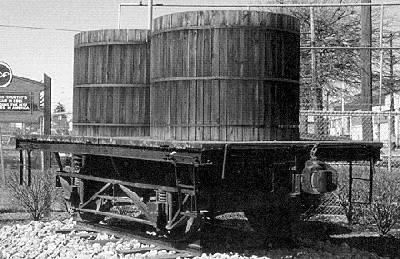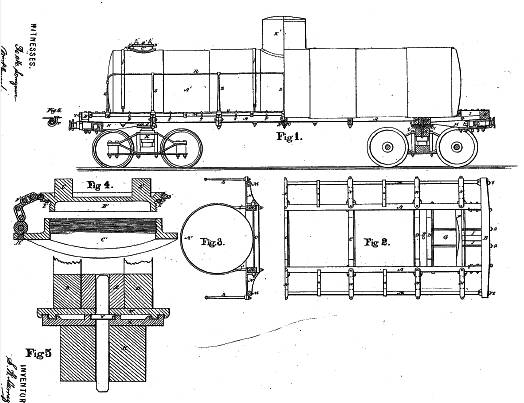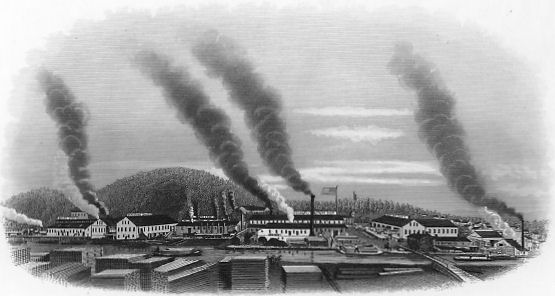Murray, Dougal & CompanyMilton Car Works
However that may be, the firm of Murray, Dougal & Company was organized and the erection of the Milton Car Works was begun in 1864. A history of the day says during the first years of its existence a number of changes were made in the ownership of the firm, but that it was finally composed of William McCleery, Samuel W. Murray, William P. Dougal and Charles C. McCormick. When the firm was started, Pennsylvania was in the midst of an oil boom, and in 1865 Murray-McDougal built a small flat car with two wooden tubs for the transportation of oil. Dubbed a “tub car,” this car is believed to be one of the first tank cars ever built.
The car works grew slowly during the next 15 years, and during the 1870s, Murray, Dougal & Company also built iron bridges. Very likely their entry into this business had something to do with the lack of orders experienced by car builders as a result of the financial panic of 1873 and the extended depression that resulted. The New York Times for 2 November 1873 reports the molders at Milton were “working but four days in the week.” At least one of these bridges still exists: a Pratt truss carrying River Street in Keesville, NY, over the Ausable River, and known as the Upper Bridge or the Upper River Bridge. It was designed by S.W. Murray and built in 1877 or 1878 by Murray, Dougal & Company. In 1880, Milton, as so many towns of that age, was to have its “great fire.” One report states it destroyed 668 building in a swath seven blocks long by two blocks wide. Only two places of business escaped destruction. Relief was sent from all around, and people were even evacuated by train to other communities for shelter. The entire car works was destroyed. The reported cause of the fire was sparks from the sawmill attached to the car works. {119} Though other portions of the plant were replaced with substantial stone and brick buildings, the bridge department was never rebuilt. For a time the firm also did a great deal of construction of oil storage tanks and steam boilers, but its continuing business was the manufacture of railroad freight cars.
McCleery had retired in 1875, McCormick had withdrawn in 1878 and Dougal retired a little later that same year, but business was still conducted under the name of Murray, Dougal & Company. In 1880 the firm was reorganized as a limited partnership that included C. H. Dickerman and B. C. Carter, but apparently the original name was retained. Shortly thereafter William B. Kramer became a partner, and in 1881 B.M. Longmore became a partner. In 1891 the capacity of the plant was judged to be 10 thirty-ton hopper cars a day or 3,000 cars a year, with average employment of 400 workers. The plant contained a saw mill that specialized in oak lumber and had 16 acres of pool for the storage of logs, which were purchased along the Susquehanna river and its tributaries and brought from Muncy dam by the canal. The plant was then located between the Philadelphia & Erie railroad and the West Branch canal, with a branch from the Philadelphia & Reading railroad running into it. In 1899, Murray, Dougal & Company was one of the 13 independent car builders consolidated into the American Car & Foundry Company. AC&F chose to continue the tank car as the main product of its Milton plant, though by now it was built largely of rolled steel plate with riveted seams. Besides crude oil, they were now used to haul edible oils such as molasses, fish oil and vegetable oil as well as petroleum products such as asphalt, gasoline, lubricating oil and tar. During the 1st World War the chemical industry expanded greatly, and the Milton plant began producing tank cars for the transportation of chemicals. Just before the depression, the Milton plant was producing up to 20 tank cars a day. By 1938 welding techniques had improved to the point that the welded tank replaced the riveted one. During the 2nd World War, the Milton plant supplied the army with tank cars, pressure vessels for overseas service, masts and keyposts for Liberty Ships, locomotive tenders, heat exchangers and high-chrome tanks for the manufacture of penicillin. In the years since, the Milton plant has continued to produce tank cars of many different designs, and since 1963 has also manufactured ACF Center Flow hopper cars. Cast of Characters —Most of what follows is from the History of Northumberland County, Pennsylvania by Herbert C. Bell (Chicago, IL: Brown, Runk & Co., Publishers, 1891) which is online at several different places. Dr.
William McCleery (1823-????) was one of the best known medical
practitioners in Northumberland county. He “read medicine” with Dr. James S.
Dougal, the father of his later business partner William Dougal, and graduated
from Jefferson Medical College in the class of 1827. After more than 30 years
as a physician, in 1857 he turned over his practice to his eldest son, and
went into the lumber business, erecting the first steam saw mill on the river. In September 1856 Murray went to Williamsport, PA, where he went into the machine business with William Vanderbilt and Charles Bowman, doing business as Vanderbilt, Murray & Bowman. When their plant was destroyed by fire less than a year later, they purchased the business of John B. Hall. But during the following summer they were hit by the great commercial crash of 1857, in which 5,000 businesses failed nationwide. They then sold the business back to Mr. Hall and gave up. Murray next worked a year in the shops of the Pennsylvania Railroad at Pittsburgh. Then he worked a year at the Baldwin Locomotive Works at Philadelphia. In 1860 he got into the implement manufacturing business at Lewisburg. In 1864 he moved to Milton, where he was the senior founding partner in Murray, Dougal & Company. Captain William P. Dougal (1823-1890) was born in Milton, and attended school there. He started out in farming and pursued that occupation until the start of the Civil War. On 4 September 1862 he was commissioned a first Lieutenant in the Pennsylvania Volunteers. He was promoted to Captain on the field at Gettysburg 1 July 1863, where he was severely wounded, and discharged 1 February 1864. He returned to Milton, where he participated in the organization of Murray, Dougal & Company. Dougal was active with the firm only until 1878, when he retired. General Charles C. McCormick (1838-1884) attended the McEwensville Academy and Lewisburg University, and took a course at the Pittsburgh Commercial College before coming with his parents to Milton in 1860. During the Civil War he rose from the rank of Private to that of Brigadier General, and after the war was promoted to Major General of the Pennsylvania National Guard. After the war he became a partner in Murray, Dougal & Company, from which he retired in 1877. |


